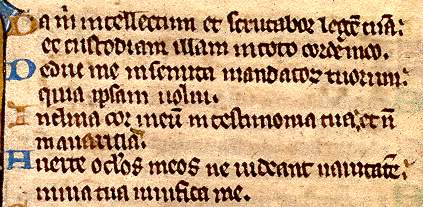Script Type : minuscule
Date : 12th to 15th centuries, this example from the13th century.
Location : Spread from France and the Low Countries across western Europe. This example is supposedly from Flanders.
Function : Book hand

























Distinctive letters : The script of this page, from the 13th century when Gothic had become fully developed, shows why this style of book hand has been called textura. The construction of all the letters from angular strokes which kink to the left at the top and the right at the bottom does give a visual reference to a woven textile. The effect is made more prominent because all the letters are very much the same size, with ascenders and descenders both tending to be short and angular. The letters do not so much have feet as an angular flick at the bottom. It looks all very artful, but can actually be quite hard to read, as the letters composed of minims and other short angular strokes are easily confused, especially as they tend to be pushed together.
This script is not extremely laterally compressed, as individual letters tend to be squarish and there are not many fully conjoined letters. A couple of examples are 

Distinctive letters include a, which has the fully enclosed two chambered form. The letter c is angular, while t is very short so that these two letters are easily confused, as they often were in medieval spelling. The ascender on d is short and bends backwards in the fully Gothic form.
There are two forms of r, including the simplified form which only appears after o. The terms long s and short s are not quite appropriate here, as the tall open s which appears at the beginning and in the middle of words is actually fairly short and chunky, while the curly s which appears at the ends of words is quite tall.
The letters i and j are not differentiated in any way, and neither are u and v.
There are no examples of k, w, y or z.
Pass the cursor slowly along the lines of text for a quick transcript. To look at the whole page in more detail, proceed to the paleography exercise.
Paleography
exercises using Flash![]()
Requires at least the Flash 5 plugin
If you are looking at this page without frames, there is more information about medieval writing to be found by going to the home page (framed) or the site map (no frames).